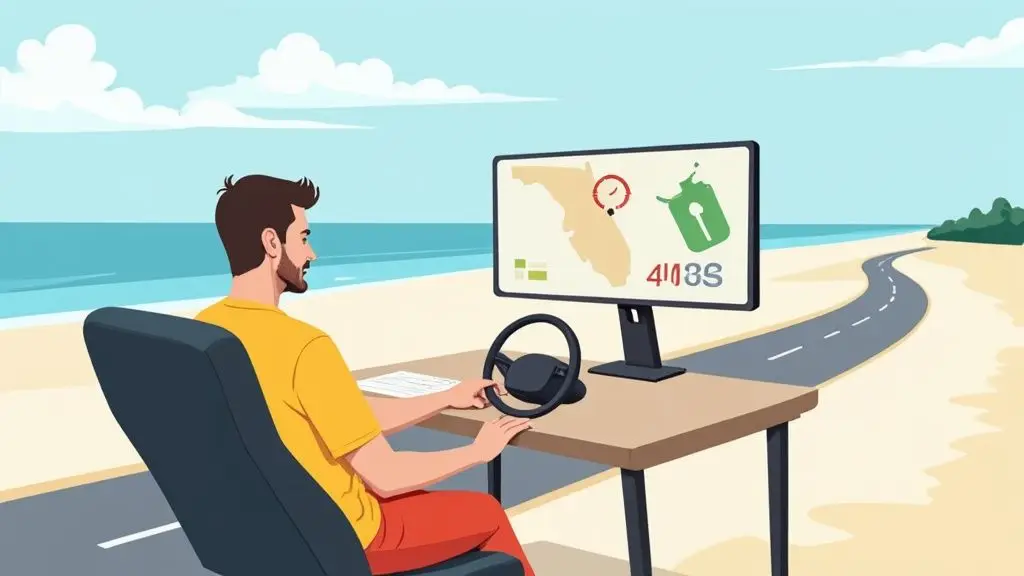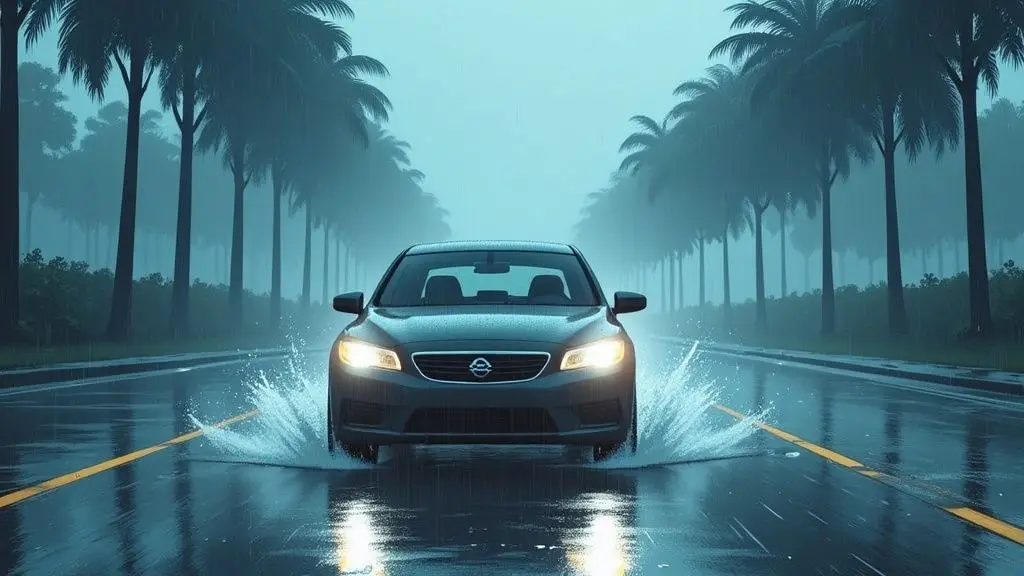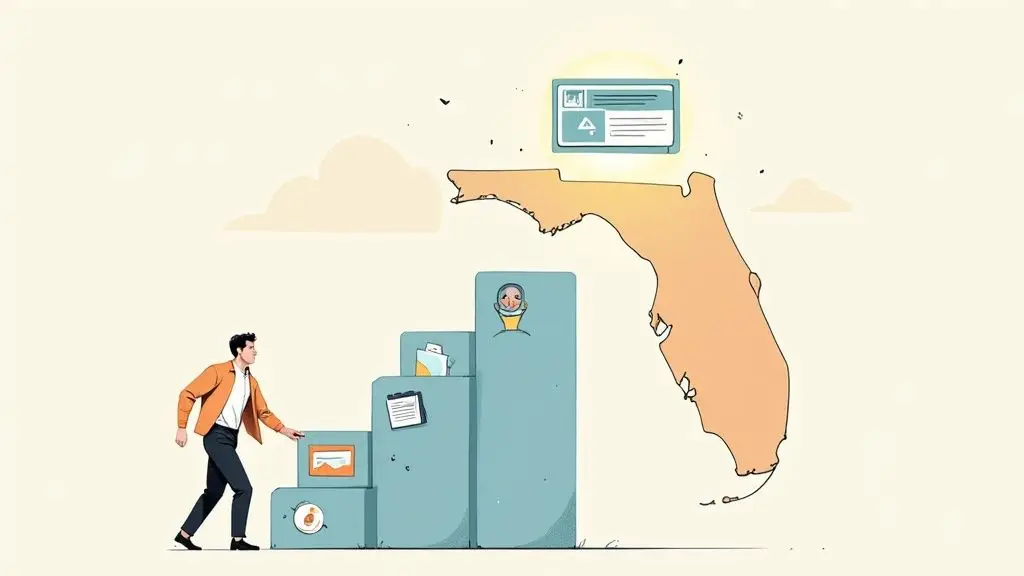It’s a driver’s worst nightmare: you press the brake pedal, and it goes straight to the floor. Nothing happens. That heart-stopping moment is when your next 10-20 seconds of action matter most.
The instant you realize your brakes are gone, your first instinct might be to panic. Don’t. Your immediate, deliberate actions can make all the difference between a close call and a serious accident.
Stay Calm and Warn Everyone
First things first: take a deep breath and keep your eyes on the road. Avoid any sudden swerves or jerky steering. Your goal is to keep the car straight and predictable for other drivers.
Immediately hit your hazard light button. This is the universal sign for trouble, and it’s the fastest way to tell everyone around you—in front, behind, and to the sides—that you have a problem. This simple action buys you precious space and time.
Try to Get Your Brakes Back
Before you do anything else, try to revive your primary brakes. Stomp on the brake pedal hard and fast, pumping it repeatedly. Sometimes, this can build up just enough hydraulic pressure to give you some stopping power. It might not be much, but even a little bit of braking can help you start slowing down.
This infographic lays out the critical first steps in that exact moment.
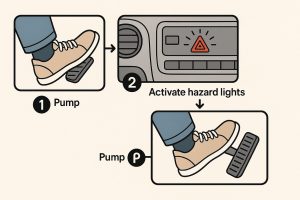
As the visual shows, pumping the brakes and signaling for help are your two most important priorities. If pumping does absolutely nothing, you’ll need to move on to your backup options immediately.
For a quick summary of what to do in those first few seconds, here’s a checklist.
Brake Failure Immediate Action Checklist
| Action | Why It’s Critical |
|---|---|
| Stay Calm | Panic leads to poor decisions. A clear head is your best tool. |
| Foot Off The Gas | Instantly stops the car from accelerating further. |
| Turn On Hazard Lights | Immediately alerts all other drivers that you’re in distress. |
| Pump The Brakes | This is your best chance to restore hydraulic pressure and regain some braking. |
Committing these four steps to memory ensures you react correctly without having to think.
Key Takeaway: Whatever you do, do not turn off the engine. This will kill your power steering and could even lock the steering wheel, leaving you with no control at all.
Knowing how to react in an emergency is a huge part of being a safe driver. You can learn more about anticipating and avoiding dangerous situations with these defensive driving tips.
Slowing Your Car Without Brakes
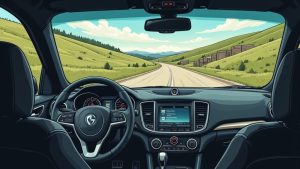
If pumping the pedal or pulling the emergency brake isn’t cutting it, your engine is your next best friend. This is where a technique called engine braking comes in. Essentially, you’re using the engine’s own compression to fight the car’s momentum, slowing you down without ever touching the brakes. It’s an incredibly effective method, but it demands a cool head.
The idea is to downshift, which forces your engine to run at higher RPMs. That creates natural resistance that slows the wheels. The absolute key here is to do it gradually. Panicking and jamming the car into first gear is a recipe for disaster—you could wreck your transmission or, even worse, lose control entirely.
Downshifting in an Automatic Car
If you’re in an automatic, look at your gear selector. You’ll see Drive (D), but you likely also have a 3, 2, and maybe an L (Low). Your job is to shift down one gear at a time. Move the shifter from D to 3 and feel the car start to slow.
You’ll hear the engine get louder as the RPMs climb; that’s a good sign, it means the engine is working to slow you down. Let the car settle for a few seconds before shifting down again to 2. This step-by-step process is the safest way to bring your speed down.
Using a Manual Transmission
Driving stick? The concept is identical, but your footwork is more involved. Push in the clutch, shift down one gear (say, from fifth to fourth), and then ease the clutch out. Don’t just dump it—that can jolt the car violently and might even lock up the drive wheels.
Keep repeating this process, one gear at a time, until you’re safely crawling along in first or second. This controlled deceleration is a lifesaver, especially on steep downhills where gravity is actively working against you. In fact, knowing how to do this is one of the most useful tips for driving in the rain, as it helps you maintain traction when your brakes might be less effective on slick roads.
Expert Tip: Whatever you do, never shut off the engine to slow down. This kills your power steering and can even lock the steering wheel, leaving you unable to steer at all.
When all other options are exhausted and a collision seems imminent, there’s one final, high-risk maneuver: using friction. This is your absolute last resort. Carefully and gently steer the car so that its side begins to scrape along a guardrail or concrete median. It’s going to make a horrifying noise and send sparks flying, but that friction will bleed off your speed. The goal is a long, controlled scrape, not a sharp impact that could spin you out of control.
Finding A Safe Place To Stop
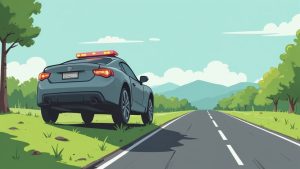
Alright, you’ve managed to scrub off some speed, but the car is still moving. Now comes the final, critical step: getting it to a complete stop without causing a wreck. This is all about situational awareness and making a smart call based on what’s around you. Keep those hazards flashing and don’t be shy with the horn—short, loud bursts will get other drivers’ attention. You need everyone to know you’re in trouble.
Your eyes are your best tool right now. Scan everything—ahead, to the sides, anywhere you can go. You’re hunting for an escape route, the path of least resistance that minimizes the danger to you and everyone else.
Assess Your Environment for Safe Zones
Ideally, you can find a wide-open area to coast to a stop. This means looking way down the road, not just at the car in front of you, and spotting a potential safe zone long before you get there.
Be on the lookout for places like:
- An empty parking lot: The gold standard. It gives you tons of room to roll to a stop far from any obstacles.
- A long, grassy shoulder: Don’t hesitate to use it. Soft ground like grass, dirt, or even sand will create a ton of friction and slow your car down surprisingly fast.
- An uphill slope: See a side road or even a long driveway that goes uphill? Take it. Gravity is your best friend here, and it will do the work of a brake pedal for you, bleeding off your momentum.
Any of these options is infinitely better than rolling into an intersection or staying trapped in the flow of traffic.
Expert Tip: Your absolute priority is avoiding a collision with other people. Get your vehicle out of the path of other cars, even if it means bumping over a curb, driving onto a lawn, or pulling into an empty field. Property damage can be fixed.
Navigating Difficult Scenarios
Of course, life rarely hands you the perfect, wide-open field right when you need it. If you’re hemmed in by heavy traffic or navigating a tight, two-lane road, you have to adapt.
In a traffic jam, keep laying on the horn and look for gaps between lanes you can filter through. On a road bordered by a guardrail, you can scrape the car along it as a desperate last resort to create friction and slow down. But your best bet is to aim for any shoulder, turnout, or patch of dirt you can find. Every foot of space you can put between your car and other moving vehicles is another second you get to think and slow down safely.
Why Brakes Fail And How To Prevent It
Once you’ve managed to stop the car and your heart rate returns to normal, you’re left with one big question: How did that even happen? Figuring out the “why” is the key to making sure you never have to go through that again. The truth is, brakes rarely fail without giving you some kind of warning first.
Most of the time, the problem comes down to a few core mechanical issues. The most common culprit is a loss of hydraulic pressure. Think of brake fluid as the lifeblood of your braking system; if it leaks out from a brake line or if the master cylinder fails, there’s nothing left to transmit the force from your foot to the wheels.
Common Warning Signs of Brake Trouble
Your car is always talking to you, and it’s your job to listen. Catching the subtle clues early can mean the difference between a simple fix and a terrifying emergency.
Keep an ear out and a foot ready for these tell-tale signs that your brakes need a professional look:
- A Spongy or Soft Pedal: If your brake pedal feels mushy or sinks slowly to the floor when you press it, that’s a classic sign of air in the lines or low brake fluid.
- Grinding or Squealing Noises: That high-pitched squeal you hear is often the built-in wear indicator on your brake pads telling you they’re getting thin. If you hear a deep, metallic grinding, stop driving immediately. That’s the sound of metal-on-metal, and it’s doing serious damage.
- Pulling to One Side: Does your car try to change lanes on its own when you hit the brakes? This usually points to a stuck brake caliper or pads that have worn down unevenly.
- Vibrations When Braking: A shaking steering wheel or a pulsating feeling in the brake pedal is a dead giveaway for warped brake rotors, which severely impacts your ability to stop smoothly and quickly.
Ignoring these red flags is a risk you just can’t afford to take. In fact, faulty brakes are a leading mechanical cause of traffic accidents. A detailed analysis found that defective brakes accounted for 42% of all crashes caused by mechanical failure, with cars over 10 years old being especially at risk.
Key Insight: Think of proactive maintenance as your car’s best safety feature. A quick check once a month can be the difference between a routine trip to the mechanic and a terrifying roadside emergency.
Staying ahead of problems is easier than you think. For a deeper dive into keeping your car in shape, check out our complete guide to Florida vehicle maintenance. Adopting this mindset helps you stay in control, ensuring your car is a reliable partner for every journey.
What to Do After You Have Safely Stopped
You did it. The car is stopped, and you’re still in one piece. Take a deep breath—that was a massive achievement. But what you do next is just as crucial for keeping everyone safe.
First things first, make absolutely sure your car isn’t going anywhere. Shift the transmission straight into Park. Then, pull that parking brake up as far as it will go. Even if the ground looks perfectly flat, do it. You can’t take any chances.
From this point on, your car is officially out of commission. Don’t even think about trying to drive it again, not even for a few feet. It’s time to call a tow truck. This isn’t a negotiable step.
Getting Help and Documenting the Incident
With the car secured and safely off the road, it’s time to get your phone out.
When you call for a tow, be crystal clear about what happened. Don’t just say you broke down; tell the dispatcher you experienced a total brake failure. This lets them know how serious it is and that the vehicle is completely unsafe to operate.
Crucial Reminder: Your only job right now is to stay safe. This is not the time to pop the hood and play mechanic on the side of a busy road. Wait for the professionals.
If the brake failure led to a collision, you’ll have another set of procedures to follow. Knowing the expert steps to follow after a car accident can make a stressful situation a little more manageable. We also have a comprehensive checklist in our guide on what to do after a car accident that walks you through everything.
Your Top Questions About Brake Failure Answered
Thinking through what to do when your brakes give out brings up a lot of specific “what if” scenarios. Let’s tackle some of the most common questions drivers have, so you’re better prepared for those tricky situations on the road.
Does The Emergency Brake Always Work?
For the most part, yes. Your emergency brake (or parking brake) is a lifesaver because it’s a completely separate mechanical system from your main hydraulic brakes. It’s designed to be a fallback for this exact reason.
Just remember, it doesn’t have the stopping power to bring you to a screeching halt from highway speeds. The key is to apply it smoothly and steadily. If you yank it up aggressively, you risk locking up the rear wheels, which could easily send you into a dangerous skid.
Is The Process Different For An Automatic vs. A Manual?
The fundamentals are the same no matter what you drive: stay calm, alert others, and use that emergency brake. The main difference comes down to how you use your engine to help slow the car down.
- Automatic Transmission: Gradually shift down to the lower gears. You’ll usually see these marked as L, 2, or 1. Just be sure to go down one gear at a time to prevent any damage to your transmission.
- Manual Transmission: This is where you have a bit more control. Press the clutch, shift down a gear (say, from 5th to 4th), and gently let the clutch out. Repeat this process, working your way down through the gears.
What If My Brakes Fail On A Steep Downhill?
This is one of the most frightening situations you can face, as your car will pick up speed incredibly fast. Your absolute first move has to be downshifting to get the engine to help slow you down.
Next, start pumping the emergency brake in firm, short bursts. Don’t just hold it down continuously, as this can cause the brake components to overheat and become useless when you need them most.
Crucial Tip: Whatever you do, never turn off the engine to try and stop the car, especially on a hill. You’ll instantly lose your power steering, making it almost impossible to steer the vehicle to safety.
It’s a sobering thought, but worldwide, road crashes lead to roughly 1.19 million deaths annually, and sudden mechanical failures are a contributing factor. You can find more global road safety statistics on WHO.int.
At BDISchool, we know that confident, knowledgeable drivers are safer drivers. Our state-approved Basic Driver Improvement course is designed to equip you with the skills to handle emergencies just like this one. Enroll today at bdischool.com and take control of your safety on the road.
